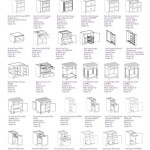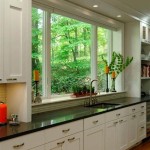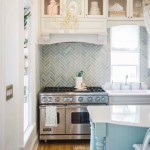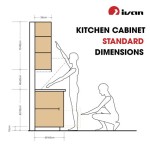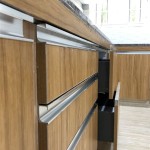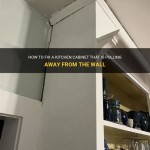Kitchen Cabinet Drawer Keeps Opening: Troubleshooting and Solutions
A common household frustration arises when kitchen cabinet drawers repeatedly fail to remain closed, impacting kitchen functionality and aesthetics. This persistent issue can stem from various underlying causes, ranging from simple misalignment to more complex mechanical failures. Identifying the root of the problem is the first crucial step towards implementing an effective solution. This article provides a comprehensive overview of potential causes and practical remedies to address the issue of a kitchen cabinet drawer that persistently opens.
Understanding the Underlying Causes
Several factors contribute to a kitchen cabinet drawer's propensity to open unexpectedly. These causes can be broadly categorized as alignment problems, hardware issues, installation deficiencies, and environmental factors. A thorough assessment of each of these areas is necessary to pinpoint the specific reason behind the recurring issue.
Misalignment: Drawer boxes and cabinet frames must be perfectly aligned for proper closure. Even slight deviations can create enough friction or resistance to force the drawer open over time. Misalignment may arise from the cabinet's initial installation, settling of the house foundation, or loose cabinet mounting screws.
Hardware Issues: Drawer slides, hinges (in the case of drawers disguised as doors), and closing mechanisms are all susceptible to wear and tear. Worn rollers, bent slides, or broken latches can create friction and prevent the drawer from staying shut. Faulty magnetic catches or other closing devices can also lose their effectiveness, leading to the drawer drifting open.
Installation Deficiencies: Improper installation is a prevalent cause of drawer problems. Cabinets that are not level or plumb will invariably lead to issues with drawers sliding open. Using inadequate or incorrect hardware during installation can also contribute to long-term stability problems.
Environmental Factors: Fluctuations in humidity and temperature can affect wood cabinets, causing them to expand and contract. This movement can gradually alter the alignment of the drawer and cabinet frame, leading to the drawer opening. Similarly, external vibrations, such as those from nearby appliances or heavy foot traffic, may cause the drawer to gradually inch open.
Diagnosing the Problem: A Step-by-Step Approach
Before implementing any solutions, a systematic diagnostic process is essential. This involves a careful examination of the drawer, the cabinet frame, and the associated hardware. A methodical approach will allow for the identification of the specific problem area and guide the selection of the appropriate fix.
Visual Inspection: Begin by visually inspecting the drawer and cabinet frame for any obvious signs of misalignment, damage, or wear. Look for gaps between the drawer front and the cabinet frame, uneven spacing along the drawer's edges, or visible warping or distortion of the wood. Also, check for loose screws, broken hardware, or debris obstructing the movement of the drawer.
Level Check: Use a level to confirm that the cabinet frame is level both horizontally and vertically. Place the level on the top, bottom, and sides of the cabinet to assess its alignment. If the cabinet is not level, this could be contributing to the drawer's tendency to open. The drawer itself also needs to be checked for squareness. A warped drawer will not sit snugly in its opening.
Slide Examination: Carefully examine the drawer slides for any signs of damage, wear, or misalignment. Check for bent tracks, loose screws, or debris obstructing the rollers. Try moving the drawer in and out to assess the smoothness of the slide action. Any resistance or jerky movements indicate a potential problem with the slides.
Latch and Closing Mechanism Assessment: If the drawer utilizes a latch or magnetic catch, thoroughly inspect its functionality. Ensure that the latch engages properly and that the magnetic catch provides sufficient holding force. Test the closing mechanism by gently pushing the drawer closed and observing whether it stays securely in place.
Implementing Solutions: Practical Remedies
Once the cause of the problem has been identified, various solutions can be implemented to remedy the situation. These solutions range from simple adjustments to more complex repairs or replacements. Selecting the appropriate solution depends on the specific nature of the problem and the skill level of the individual performing the repair.
Adjusting Drawer Alignment: If misalignment is the primary issue, shimming the cabinet frame or adjusting the drawer slides can help to correct the problem. Small shims can be placed behind the cabinet frame to level it or to adjust the spacing around the drawer opening. Drawer slides can often be adjusted by loosening the mounting screws and repositioning the slide until the drawer sits squarely in the opening. Re-tighten the screws once the drawer is properly aligned.
Tightening Screws: Loose screws are a common cause of drawer problems. Inspect all screws associated with the drawer slides, cabinet frame, and drawer box, and tighten them securely. If the screw holes are stripped, consider using wood glue and toothpicks to fill the holes before re-inserting the screws. This will provide a better grip and prevent the screws from loosening again.
Replacing Worn Hardware: If the drawer slides, hinges, or closing mechanisms are worn or damaged, they should be replaced. Purchase replacement hardware that is identical to the original hardware to ensure proper fit and function. Follow the manufacturer's instructions for installing the new hardware. When selecting replacement drawer slides, consider upgrading to soft-close slides for improved performance and durability. Soft-close slides prevent the drawer from slamming shut and can help extend the life of the cabinet.
Reinforcing Cabinet Structure: Weak or unstable cabinet structures can contribute to drawer problems. Reinforce the cabinet by adding bracing or supports to the back or sides of the cabinet. This can help to stabilize the cabinet and prevent it from shifting or warping over time. Consider adding corner braces to the inside corners of the cabinet frame for added strength.
Adding Latches or Catches: If the drawer is not equipped with a latch or magnetic catch, consider adding one to help keep it closed. Various types of latches and catches are available, including magnetic catches, roller catches, and touch latches. Choose a latch or catch that is appropriate for the style of your cabinet and the level of security required. Install the latch or catch according to the manufacturer's instructions.
Addressing Environmental Factors: To mitigate the effects of humidity and temperature fluctuations, consider installing a dehumidifier or air conditioner in the kitchen. This can help to maintain a more stable environment and prevent the wood cabinets from expanding and contracting excessively. Also, avoid placing heavy objects on the drawer that could contribute to warping or misalignment.
Modifying Drawer Fronts for a Snug Fit: In cases where a slight gap exists between the drawer front and the cabinet frame, consider applying weather stripping along the inside edges of the drawer opening. This thin strip of foam or rubber can provide a snug fit, preventing the drawer from drifting open and reducing drafts. The weather stripping should be thin enough to not impede closing, but thick enough to provide a little added friction.
Re-leveling the Cabinet: If the cabinet is significantly out of level, it may be necessary to re-level it. This involves removing the cabinet from the wall and shimming it until it is level. Use a level to ensure that the cabinet is plumb before reattaching it to the wall. Secure the cabinet to the wall studs using appropriate screws or anchors.
Dealing with Damaged Drawer Boxes: If the drawer box itself is warped, cracked, or otherwise damaged, it may need to be repaired or replaced. Minor cracks can be repaired with wood glue and clamps. However, if the drawer box is severely damaged, it is best to replace it. Measure the dimensions of the existing drawer box carefully and purchase a replacement drawer box that is the same size and style. Install the new drawer box in the cabinet, ensuring that it fits properly and slides smoothly.
When to Consult a Professional: If the problem persists despite implementing these solutions, or if the repairs required are beyond your skill level, it may be necessary to consult a professional carpenter or cabinet maker. A professional can diagnose the problem accurately and provide a more comprehensive solution. They can also address more complex issues such as structural damage to the cabinet or significant misalignment of the cabinet frame.
Regular maintenance and preventative measures are crucial in minimizing the likelihood of future problems. Periodically inspect the drawer slides, hinges, and closing mechanisms for wear and tear. Tighten any loose screws and lubricate the moving parts as needed. Avoid overloading the drawers with heavy items, as this can strain the hardware and contribute to misalignment. By taking proactive steps to maintain your kitchen cabinets, you can prevent future problems and ensure that your drawers remain functional and secure.
Addressing a kitchen cabinet drawer that constantly opens requires a systematic approach, starting with a thorough diagnosis of the underlying causes. By carefully examining the drawer, cabinet frame, and hardware, the specific problem area can be identified, and an appropriate solution can be implemented. From simple adjustments to hardware replacements, various remedies are available to address the issue. In more complex cases, consulting a professional may be necessary. Proactive maintenance and preventative measures can also help to minimize the likelihood of future problems.

How To Keep Drawers Or Cabinets Sliding Open By Itself Easy Method

How To Remove Soft Close Drawer Kitchen

How To Fix A Sliding Out Drawer Bunnings Work Community

During An Inspection I Pulled Open A Kitchen Cabinet Drawer And It Slid Right Out Completely Unsecured This Kind Of Issue Might Seem Small But Can Lead To Injuries Shows Signs Poor

Kitchen Cabinet Drawer Latches For Our Skoolie

How To Organize Kitchen Drawers The Organized Mama

Kitchen Cabinet Organizers Diy Pots And Pans Storage Tylynn M

How To Organize Kitchen Drawers Thistlewood Farm

Easy Steps And Tips For Organizing Your Kitchen Drawers Bluesky At Home

This Clever Cabinet Will Help To Keep Your Kitchen More Organized
Related Posts

